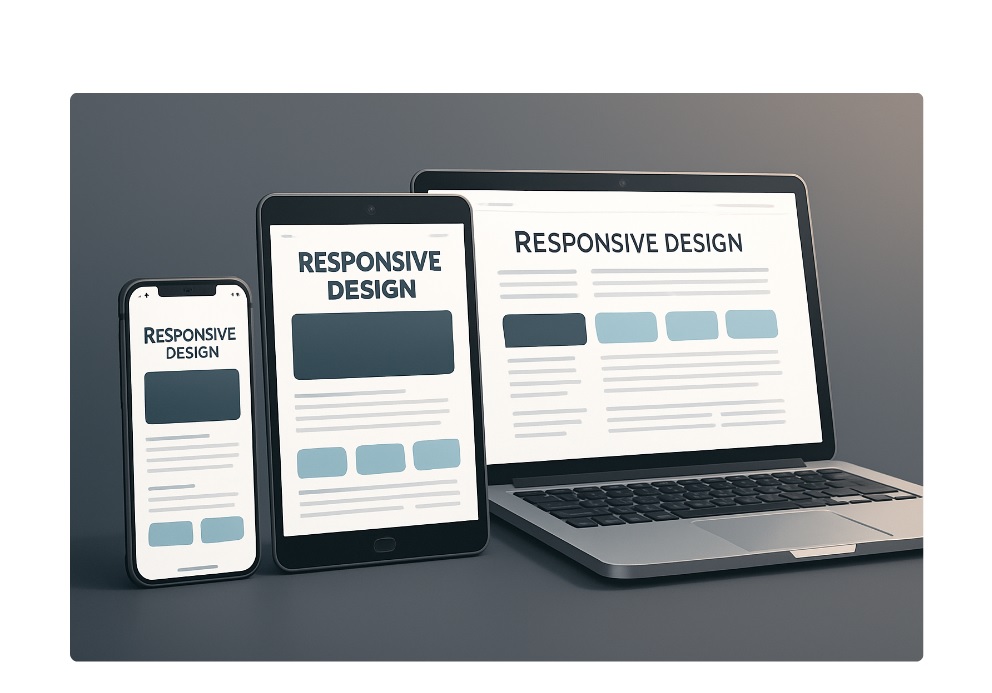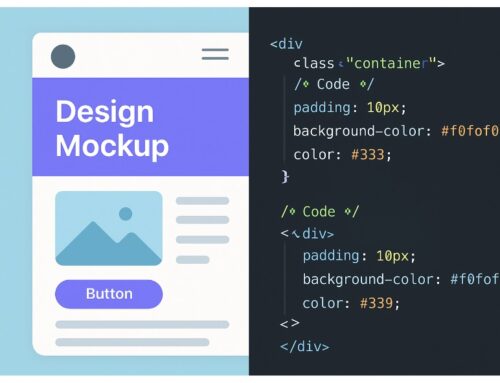
The Ultimate Guide to Responsive Web Design in 2025: Why Mobile-First is No Longer Optional
Introduction: The Mobile Revolution and the Imperative of
Responsive Design
In the dynamic digital landscape of 2025, a website is no longer a static brochure; it’s an
interactive experience, a crucial touchpoint in your customer’s journey. The days of
designing solely for desktop screens are long gone. With the proliferation of smartphones,
tablets, smartwatches, and an ever-expanding array of internet-connected devices, the way
users access and interact with online content has fundamentally shifted. This seismic
change has elevated responsive web design from a desirable feature to an absolute
necessity. For businesses aiming to capture, engage, and convert their audience, a mobile-
first approach is not just a trend; it’s the bedrock of a successful digital strategy.
At Webdev-creations, with our 8 years of agency experience and our founder’s 17 years in
graphic design and advertising, coupled with a decade in web design and development,
we’ve witnessed this evolution firsthand. We understand that a truly effective website in
2025 must be fluid, adaptable, and seamlessly deliver an optimal user experience (UX)
regardless of the device or screen size. This comprehensive guide will delve into why
responsive web design is more critical than ever, explore the principles of mobile-first
design, and equip you with the knowledge to ensure your website looks flawless and
performs exceptionally on every device.
Why Responsive Design is Non-Negotiable in 2025
The digital ecosystem is more diverse than ever. Users are constantly switching between
devices, expecting a consistent and high-quality experience. Here’s why responsive web
design is no longer an option, but a fundamental requirement for any business aiming for
online success:
1. Dominance of Mobile Usage
Mobile devices now account for the majority of web traffic worldwide. According to Statista,
mobile devices generated 59.43% of global website traffic in the first quarter of 2024 [1].
This trend is only set to continue, making it imperative that your website is optimized for
mobile users. A non-responsive site on a mobile device leads to frustrating experiences,
such as tiny text, difficult navigation, and endless zooming and scrolling, which inevitably
drives users away.
2. Enhanced User Experience (UX)
User experience is king. A responsive website provides a seamless and intuitive browsing
experience across all devices. Content automatically adjusts, images scale appropriately,
and navigation remains accessible. This consistency reduces friction, improves
engagement, and fosters a positive perception of your brand. A good UX translates directly
into higher conversion rates, whether it’s a purchase, a lead form submission, or a
subscription.
3. Improved SEO Performance
Google, the undisputed leader in search, prioritizes mobile-friendliness. Since 2015, Google
has used mobile-friendliness as a ranking factor, and with its shift to mobile-first indexing,
the mobile version of your website is now the primary version used for indexing and ranking[2]. A responsive design ensures that your site is easily crawlable and indexable by search
engines across all devices, leading to better search engine rankings, increased organic
traffic, and higher visibility.
4. Cost-Effectiveness and Efficiency
Maintaining a single responsive website is significantly more cost-effective and efficient
than developing and managing separate websites for different devices (e.g., a desktop site
and a separate mobile site). Responsive design streamlines development, reduces
maintenance overhead, and simplifies content updates, saving you time and resources in
the long run.
5. Future-Proofing Your Online Presence
The digital landscape is constantly evolving, with new devices and screen sizes emerging
regularly. Responsive design, with its flexible grid layouts and fluid images, is inherently
adaptable. This flexibility allows your website to gracefully accommodate future
technological advancements without requiring a complete overhaul, ensuring your online
presence remains relevant and effective for years to come.
6. Increased Reach and Accessibility
A responsive website ensures that your content is accessible to a wider audience, including
those with varying internet speeds and accessibility needs. By providing a consistent
experience, you cater to a broader demographic, expanding your potential customer base
and demonstrating a commitment to inclusivity.
The Core Principles of Mobile-First Design
Mobile-first design is a philosophy that flips the traditional design process on its head.
Instead of starting with a desktop design and then scaling down for smaller screens, you
begin by designing for the smallest screen first (mobile) and then progressively enhance the
experience for larger devices. This approach, championed by Google, forces designers and
developers to prioritize content and functionality, leading to leaner, faster, and more user-
friendly websites.
Here are the fundamental principles that underpin a successful mobile-first strategy:
1. Content Prioritization: Less is More
When designing for mobile, screen real estate is limited. This constraint forces you to
identify and prioritize the most crucial content and functionality. What does your user
absolutely need to see or do on a small screen? By focusing on core elements, you eliminate
clutter and distractions, ensuring a clear and efficient user journey. This minimalist
approach often results in a more focused and effective design for all screen sizes.
2. Progressive Enhancement: Building Up, Not Down
Progressive enhancement is a strategy that delivers a baseline experience to all users,
regardless of their device or browser capabilities, and then adds more advanced features
and richer experiences for those with more capable environments. In a mobile-first context,
this means ensuring your site is fully functional and accessible on basic mobile devices, and
then adding complex layouts, animations, and high-resolution media as screen size and
bandwidth allow. This guarantees a solid foundation for everyone.
3. Touch-Friendly Navigation and Interactions
Mobile users interact with websites primarily through touch. This necessitates larger, easily
tappable buttons and links, ample spacing between interactive elements, and intuitive
gesture-based navigation. Designing for
touch also means considering the ‘thumb zone’ ‒ the area of the screen most easily reached
by a user’s thumb ‒ to place critical CTAs and navigation elements within easy reach.
4. Performance Optimization: Speed is Paramount
Mobile users often access the internet on slower connections and with limited data plans.
Therefore, website speed is a critical factor for mobile-first design. Optimizing images,
minimizing code, leveraging browser caching, and using efficient loading techniques are
essential to ensure a fast and fluid experience. A slow-loading mobile site leads to high
bounce rates and a poor user experience, directly impacting your SEO and conversion rates.
5. Flexible Grids and Fluid Images: The Foundation of Adaptability
Responsive design relies on flexible grid layouts and fluid images. Instead of fixed pixel
widths, elements are designed using percentages or relative units, allowing them to scale
proportionally to the screen size. Images are also made fluid, ensuring they resize without
distortion or loss of quality. This inherent flexibility is what allows a single website to adapt
seamlessly to an infinite number of screen dimensions.
Implementing Responsive Web Design: Key Techniques
Translating the principles of responsive and mobile-first design into a functional website
requires a combination of strategic planning and technical execution.
Here are the key techniques and considerations we employ at Webdev-creations to build truly adaptive and
high-performing websites:
1. CSS Media Queries: The Responsive Backbone
Media queries are a fundamental CSS3 technique that allows content to adapt to different
screen sizes and resolutions. They enable us to apply different styles based on
characteristics of the device, such as width, height, orientation, and resolution. This means
we can define specific breakpoints where the layout or styling of your website will change to
optimize for that particular screen size. While traditional approaches often define
breakpoints for common devices (e.g., tablet, desktop), a more robust strategy involves
creating breakpoints based on content needs, ensuring the design always looks its best.
2. Flexible Grid Layouts (Flexbox & CSS Grid)
Modern CSS layout modules like Flexbox and CSS Grid are indispensable for building
responsive designs. They provide powerful and efficient ways to arrange and distribute
space among items in a container, regardless of their size. This eliminates the need for
complex float-based layouts and allows for truly fluid and dynamic content arrangement
that adapts effortlessly to various screen dimensions. We leverage these tools to create
intuitive and visually appealing structures that maintain integrity across all devices.
3. Fluid Images and Media
Images and videos are often the heaviest elements on a webpage and can significantly
impact loading times and responsiveness if not handled correctly. Fluid images are
achieved by setting their maximum width to 100% of their container, ensuring they scale
down proportionally without overflowing. For more advanced optimization, we utilize
techniques like srcset and the <picture> element to serve different image resolutions
based on the user’s device and viewport, ensuring fast loading times without compromising
visual quality. Similarly, responsive video embeds ensure media players adapt to available
space.
4. Viewport Meta Tag
The viewport meta tag is a crucial HTML element that instructs the browser on how to
control the page’s dimensions and scaling. Without it, mobile browsers might render the
page at a desktop width and then scale it down, making text unreadable. The standard meta
tag <meta name=”viewport” content=”width=device-width, initial-scale=1.0″> ensures that the page
renders at the device’s width and prevents initial scaling, providing a true responsive
experience.
5. Prioritizing Performance: Speed as a Feature
Beyond just layout, the performance of a responsive website is paramount. We implement a
range of optimization techniques to ensure fast loading times, which is critical for both user
experience and SEO. This includes:
• Image Optimization: Compressing images, using modern formats (like WebP), and lazy
loading.
• Code Minification: Reducing the size of CSS, JavaScript, and HTML files.
• Browser Caching: Storing frequently accessed resources locally to speed up
subsequent visits.
• Asynchronous Loading: Loading non-critical resources without blocking the rendering
of the main content.
• Server-Side Optimization: Ensuring efficient server response times.
6. Accessibility Considerations
Responsive design naturally contributes to better accessibility, but we go further to ensure
your website is usable by everyone. This includes proper semantic HTML, sufficient color
contrast, keyboard navigation support, and ARIA attributes where necessary. An accessible
website is not only inclusive but also often performs better in search rankings.
UI/UX Best Practices for Responsive Design
Beyond the technical implementation, a truly effective responsive website hinges on
thoughtful UI/UX design. Our 17 years of graphic design and advertising experience,
combined with 10 years in web design, allow us to craft interfaces that are not just
functional but also delightful and intuitive across all devices. Here are some key UI/UX best
practices we adhere to:
1. Content-First Approach
As emphasized in mobile-first design, content is paramount. Before even thinking about
layout, we identify the core message and essential information. This ensures that even on
the smallest screens, users receive the most critical content without unnecessary clutter.
The design then serves to enhance the content, not overshadow it.
2. Intuitive Navigation
Navigation must be clear, concise, and easily accessible on all devices. For mobile, this often
means implementing a ‘hamburger’ menu or a tab bar for primary navigation, ensuring it
doesn’t consume valuable screen space. For larger screens, a more expansive navigation bar
can be used. The key is consistency in functionality and clear labeling.
3. Large, Tappable Elements
Fingers are less precise than mouse cursors. All interactive elements, such as buttons, links,
and form fields, must be large enough and have sufficient spacing to be easily tappable
without accidental clicks. Google recommends a minimum touch target size of 48×48 pixels[3].
4. Readability and Typography
Text must be legible on all screen sizes. This involves choosing appropriate font sizes, line
heights, and letter spacing that scale well. Contrast between text and background colors is
also crucial for readability, especially in varying light conditions. Consider using fluid
typography techniques that adjust font sizes based on the viewport width.
5. Visual Hierarchy
Establish a clear visual hierarchy to guide the user’s eye through the content. On smaller
screens, this becomes even more critical as content is often stacked vertically. Use size,
color, contrast, and spacing to emphasize important elements and create a logical flow of
information.
6. Minimalist Design and Decluttering
Responsive design often benefits from a minimalist aesthetic. Removing unnecessary
elements, reducing visual noise, and focusing on clean layouts can significantly improve
user experience, especially on smaller screens where space is at a premium. Every element
should serve a purpose.
7. Feedback and Micro-interactions
Provide clear visual feedback for user actions (e.g., button presses, form submissions).
Micro-interactions, subtle animations that occur when a user interacts with an element, can
enhance the user experience, provide delightful moments, and guide users through the
interface without being intrusive.
8. Accessibility
Ensure your responsive design is accessible to all users, including those with disabilities.
This involves using semantic HTML, providing alternative text for images, ensuring keyboard
navigability, and adhering to WCAG (Web Content Accessibility Guidelines) standards. An
accessible website is a better website for everyone.
Conclusion: Your Digital Future is Responsive
In 2025, responsive web design is no longer a competitive advantage; it’s a fundamental
necessity for any business serious about its online presence. From enhancing user
experience and boosting SEO rankings to ensuring cost-effectiveness and future-proofing
your digital assets, the benefits are undeniable. A mobile-first approach, coupled with
thoughtful UI/UX practices and robust technical implementation, ensures that your website
delivers an optimal experience to every user, on every device.
At Webdev-creations, we specialize in crafting responsive, high-performing websites that
not only look stunning but also drive tangible business results. With our extensive
experience in web design, development, graphic design, and digital marketing, we are your
ideal partner in navigating the complexities of the modern digital landscape. We build
websites that adapt, engage, and convert, ensuring your brand stands out in a multi-device
world.
Ready to transform your digital presence with a truly responsive website?
Share of mobile device website traffic worldwide from 1st quarter 2015
to 4th quarter 2024. Retrieved from https://www.statista.com/statistics/277125/share-of-
website-traffic-coming-from-mobile-devices/[2] Google Search Central. (n.d.).
Mobile-first indexing (MFI) best practices. Retrieved from
https://developers.google.com/search/docs/crawling-indexing/mobile/mobile-first-
indexing[3] Google Developers. (n.d.).
Target sizes for touch targets. Retrieved from
https://developers.google.com/web/fundamentals/accessibility/accessible-and-inclusive-
design/touch-targets













